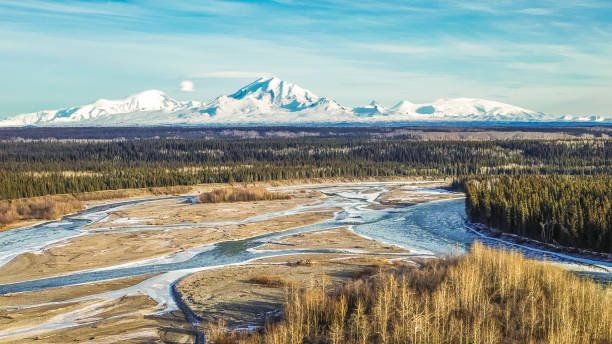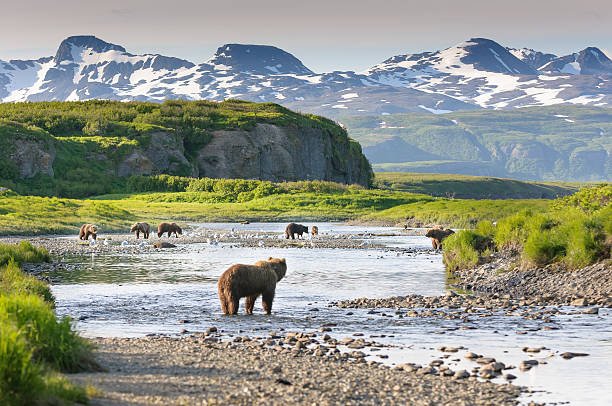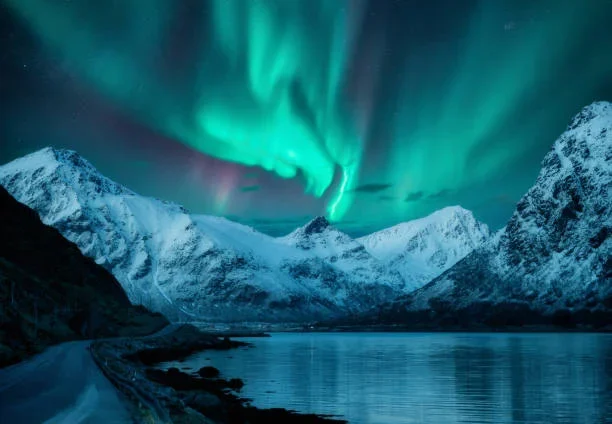Let’s explore the guide to the best national parks of Alaska and discover the beauty and adventure that awaits.
Why These 5 National Parks in Alaska Are the Best?
They are among the best due to their vast, untouched wilderness, diverse ecosystems, and breathtaking landscapes. These best national parks in Alaska offer incredible wildlife viewing, from grizzly bears to humpback whales, and unique features like Arctic tundra.

For in-depth information, top 5 best national parks in Alaska are stated below.
1. Denali National Park and Preserve

Located in the heart of Interior Alaska, it is a vast and breathtaking destination that spans over 6 million acres, surpassing the size of the state of New Hampshire. Its crown jewel is Denali, North America’s highest peak, towering at 20,310 feet (6,190 meters) above sea level.
Established in 1917 as Mount McKinley, it was renamed Denali in 2015 to honor the native Koyukon people’s name for the mountain, meaning “the tall one” or “mountain-big.” This name change acknowledges the rich cultural heritage of Alaska’s indigenous people and their deep connection to the land.
Must-see attractions

Wonder Lake: A picturesque lake with a beautiful views of Denali, accessible by bus or hiking.
Polychrome Pass: Mountains pass with amazing views of the Alaska Range.
Kantishna Hills: Area with views of Denali and the surrounding mountains.Scenic Drives and Hike

Denali Park Road: A 92-mile scenic road that runs through the park.
Wonder Lake Trail: A 20-mile round-trip hike to Wonder Lake.
Savage River Trail: A 2-mile loop hike along the Savage River.
2. Glacier Bay National Park and Preserve

This best national park in Alaska is a remarkable natural area in southeastern state, covering approximately 3.3 million acres (5,129 square miles). This expansive park features dynamic glaciers, temperate rainforests, and deep fjords, making it one of the most significant protected areas in the world.
Must-see attractions:
1. Glaciers

Margerie: A 21-mile-long glacier that is one of the most accessible and spectacular.
Lamplugh: A 12-mile-long glacier that is known for its blue color and dramatic calving.
Grand Pacific: A 25-mile-long glacier that is one of the largest and most impressive.2. Fjords and Bays

Bartlett Cove: A bay that is home to its’ visitor center and is a great place to see wildlife.
Reid Inlet: A great place to see bears and other wildlife.3. Wildlife Viewing

Humpback whales: Commonly seen in the park’s waters, particularly in Glacier Bay and Bartlett Cove.
Sea otters: Frequently seen in its waters, particularly in Bartlett Cove and Reid Inlet.
Puffins and seabirds: Can be seen in the coastal areas, particularly in Bartlett Cove and Reid Inlet.
4. Hiking and Kayaking

Bartlett Cove Trail: A 1-mile loop trail that takes you through a lush forest and offers views of Bartlett Cove.
Reid Trail: A 4-mile out-and-back trail that takes you to the foot of the Reid Glacier.
Kayaking in Glacier Bay: A great way to explore them up close.Geographical Features
It is a UNESCO World Heritage Site. It is famous for its tidewater glaciers that terminate in the ocean. Among these are notable glaciers like Margerie and Johns Hopkins, which actively calve icebergs into the bay.
The park is characterized by steep-sided mountains, fjords, and ecosystems that have emerged as they have retreated over time. The bay itself is approximately 65 miles long (105 km) and features a variety of habitats, from coastal rain-forests to alpine tundra.
Located in southeastern Alaska, this is a UNESCO World Heritage Site and one of the most biologically diverse parks in Alaska. It is home to over 1,000 glaciers, including the famous Margerie.
3. Wrangell-St. Elias National Park and Preserve

This is the one of the best and the largest national park in the United States, encompassing an area of 20,587 square miles (53,320 square kilometers) in south-central Alaska. It was designated as a national monument in 1978 and became a UNESCO World Heritage site in 1979, officially established in 1980.
It features an array, including the Wrangell Mountains, Saint Elias Mountains, and the Chugach Mountains, making it a significant geological and ecological area. It is home to 18 of the highest peaks in North America, including Mount Blackburn, the highest peak in the Wrangell Mountains.
Must-see attractions:
Mountains and Glaciers

Mount Blackburn: The highest peak in the Wrangell Mountains, and the fifth-highest peak in North America.
Mount Saint Elias: The second-highest peak in the Wrangell Mountains.Scenic Drives and Hikes

Nabesna Road: A scenic drive that takes you to the Nabesna Glacier.
Bonanza Mine Trail: A moderate hike that takes you to an old mine and offers views of the surrounding mountains.4. Katmai National Park and Preserve

It located on the northern Alaska Peninsula, is renowned for its natural beauty and diverse wildlife, particularly its population of brown bears. It is home to over 2,000 brown bears, which congregate at Brooks Falls to catch salmon. It was established on December 2, 1980, the park spans approximately 4 million acres, which is a massive area, making it one of the largest national parks in the United States. It encompasses significant geological features such as the Valley of Ten Thousand Smokes and is home to 14 active volcanoes.
Must-see attractions:
Scenic Attractions

Valley of Ten Thousand Smokes: A unique geological feature that has numerous volcanic cones and ash deposits.
Mount Peulik: A volcanic mountain.
Kukak Bay: A scenic bay that is home to a large population of brown bears and other wildlife.Hiking and Camping

Brooks Falls Trail: A short hike to the Brooks Falls viewing platform, where you can see brown bears up close.
Dumpling Mountain And Kukak Bay Trail: A moderate hike that offers beautiful views.
Back-country camping: It offers numerous back-country camping sites, where you can experience the park’s wilderness up close.
5. Kenai Fjords National Park

It established as the best national park in 1980, is located on the Kenai Peninsula in south-central Alaska. It is a natural area renowned for its rich marine life. Covering an area of approximately 669,984 acres, it features the Harding Ice-field, which is the source of at least 38 glaciers, including the prominent Bear Glacier.
Geographical Features
It is characterized by its rugged coastlines, deep fjords, and high mountains. The fjords were formed by glacial activity and are now submerged due to rising sea levels. The park’s highest point reaches 6,450 feet in the Kenai Mountains.
Must-see attractions:
Glaciers and Fjords

Exit Glacier: A short hike to the toe of the glacier, where you can witness the glacier’s majesty up close.
Harding Icefield: A scenic hike to the top of the icefield, where you can see numerous glaciers and fjords.Conclusion
These famous and best national parks offer unparalleled opportunities for outdoor adventure and soaking in nature. From the highest mountains of Denali to the Glacier Bay, each has its unique features and attractions.












